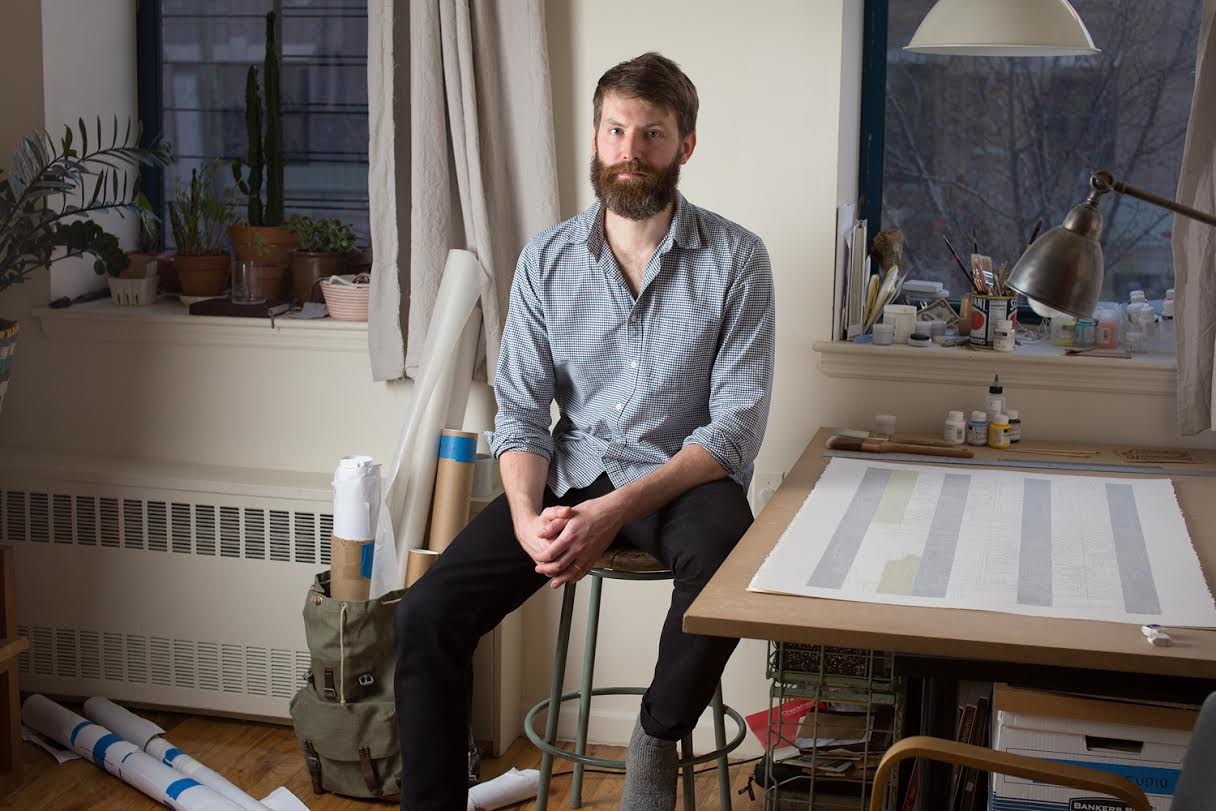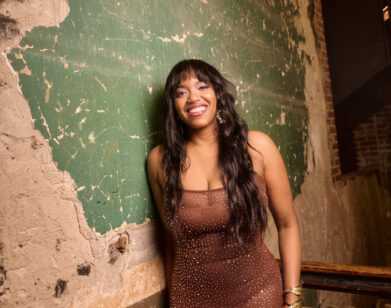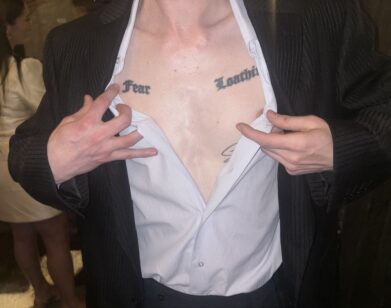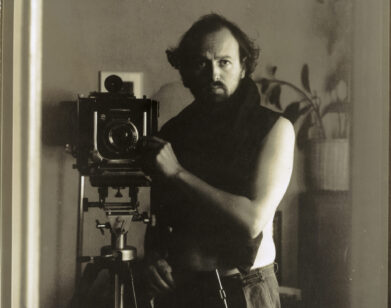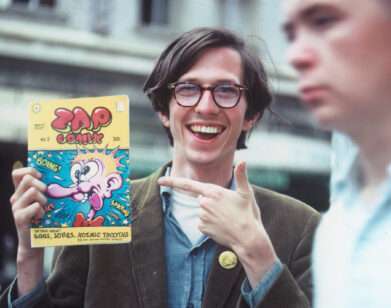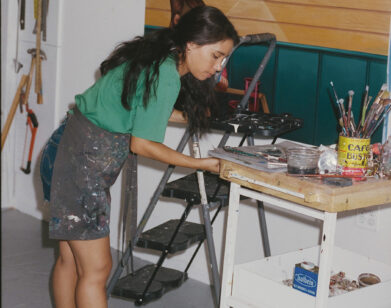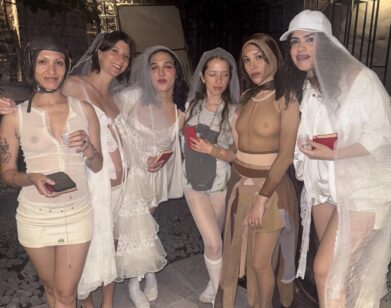Cutting Up with Samuel Stabler
Samuel Stabler’s work is thoroughly original, unlike anything out there—which is a bit odd, considering he takes a lot of inspiration from the canon. In fact, he appropriates it: Stabler redraws the Old Masters’ work in almost unbelievable detail, then obscures some of that detail with bold streaks of neon. His work is much smaller in scale than the grandiose images from which he works, and that’s the point.
Stabler is concerned with the Internet age, with the proliferation of information and images. Though indirectly and certainly not overtly, his work is a meditation on the modern viewer’s relationship to art history. We sit down to talk inspiration, creative choices, and his parents’ NSF-yearbook advice.
KAYLA TANENBAUM: Why do you use neon?
SAMUEL STABLER: I use neon because it’s contemporary. It’s a pigment that was made in the 20th century. I’m also concerned with the hierarchy of colors in religious works, and I think if there was a color like this—iridescent, radioactive color—where would it have fallen in that hierarchy? I don’t know, but I like that thought.
TANENBAUM: Since you are known for drawing the Old Masters, I’m interested in your thoughts on originality and appropriation.
STABLER: Clearly I’m okay with appropriation. It’s how you do it. I’m not pretending these aren’t other people’s paintings, but hopefully I’m respecting it and giving it a rebirth.
TANENBAUM: So is that what you’re concerned with? Rebirth?
STABLER: It isn’t the objective, but it is something that happens. A lot of [the works] are famous paintings that you immediately recognize. I find random paintings on Wikipedia that I’ve never seen before. I like that idea of putting them back out there, as something that directly influences something contemporary—me. Artists have always appropriated, sometimes very directly. Old Masters used to paint the masters before them, until they came up with something new. I feel like the Internet age has allowed me to have this huge access to information, so this is what I’m doing with it. I’m appropriating it in the way that makes sense to me now. I try to put a huge amount of skill so no one can say, “You’ve just cheapened this.”
TANENBAUM: What about scale? Your works are much smaller than the originals. Are you reducing them?
STABLER: I am reducing them to a practical scale. This is the way I gain the information on my tablet or laptop. I see them on a small screen. I find it beautiful, how we have so much information at our disposal and we consume it in a new way.
TANENBAUM: You also do cutouts. In terms of the different forms and materials, do you get different artistic fulfillment from each project?
STABLER: Yeah. They start in the same place, this intensive drawing process. The neons are explorative. I can visualize what it’s going to look like at the end, but the process of getting there is very exciting to me. The cutouts, for me, the process is very cathartic. It’s more about going through it. I like when I’m done that I’ve executed a huge amount of labor.
TANENBAUM: How do you choose the imagery for your cutouts?
STABLER: Stream of consciousness. I take advantage of the bombardment of information, and I just draw.
TANENBAUM: I feel like it would be very easy to assume ideological underpinnings about your work. I see students someday writing essays on the way you reacted to the digital age and the canon… When are you engaging with this stuff, what are you consciously thinking? Is there an ideology?
STABLER: I like that idea of people finding significance in my work. I feel like we do that with art history in general. We give a lot more credit, but it’s wonderful. It’s a beautiful thing. Personally, I do these things because I need those outlets. I need to create. I don’t know what else I would do.
TANENBAUM: But some people make art with more overt gestures, feminist, political… Are you saying you’re okay with whatever people read into your work?
STABLER: It’s fine until someone says something I don’t like. I got called a misogynist in art school for these nudes. I’d assimilated some violent gestures, I guess. I’m happy I haven’t been typecasted yet. I have a fear—not because I think my work is like this but because I think it’s the biggest insult—of being called a pastoral painter. I feel I put a lot skill into the work, but I also think there’s content. If it’s just skill, is it a pastoral painting?
TANENBAUM: Do you read your reviews?
STABLER: I do. I read all my reviews now, because there aren’t many. [laughs]
TANENBAUM: So, I was looking at your blog…
STABLER: Ah, the blog! It was my wife’s idea. It was when I was not showing anything. I had made a lot of work, and it was frustrating. She goes, “There’s this thing called a blog. You can put anything you want on the Internet.” “Oh, okay! What could go wrong?” So I did it pretty intensely for a couple of months.
TANENBAUM: Did you monetize it?
STABLER: God, no. I wouldn’t even know how to do that. They are my sketchbook drawings, primarily. I liked it. My friends liked it, so I liked it. It’s another wonderful thing about this technological age. Anyone can put shit out there. I really fear for my son… The shit I was doing as a kid, if that was ever on the Internet, I wouldn’t be here talking to you. That’s for sure. Fortunately my blog was only halfway terrible.
TANENBAUM: Do you let people see your unfinished work?
STABLER: Yeah. I ask my wife. She’s an architect so she’s very creative, very smart, but she’s not in the art world, so that’s the opinion I value. My brother, too, he’s a real estate guy.
TANENBAUM: What’s the best piece of advice you’ve ever gotten?
STABLER: “Don’t trust anyone who doesn’t drink.” Both my parents say that. [laughs] My high school quote was going to be, “Be nice to the ugly ones, because they’re going to be the best-looking ones in the future.” My dad told me that, and when I quoted my dad in my yearbook—my mom worked in the high school—she was like, “You’re not putting that in there.”
TANENBAUM: You’re currently in a group show, and you’ve exhibited solo at Gallery 151. What’s different about a group show versus a solo show?
STABLER: In a group show, you surrender control. It’s a wonderful surrender. I like the idea of putting something next to something else and having a dialogue. They each have their own value.
TANENBAUM: How do you think your work has changed since you were younger?
STABLER: It’s gotten better. Back to the best advice question, in college a professor told me to go to a grad school with a good name so I’ll be surrounded by people who are smarter than I am. Your tutors, your professors—that’s not going to mean shit. It’s your buddies who influence you.
SAMUEL STABLER’S WORK IS ON DISPLAY AT “SIX BY NINE,” A GROUP SHOW AT THE NATIONAL ARTS CLUB, THROUGH DECEMBER 14.

